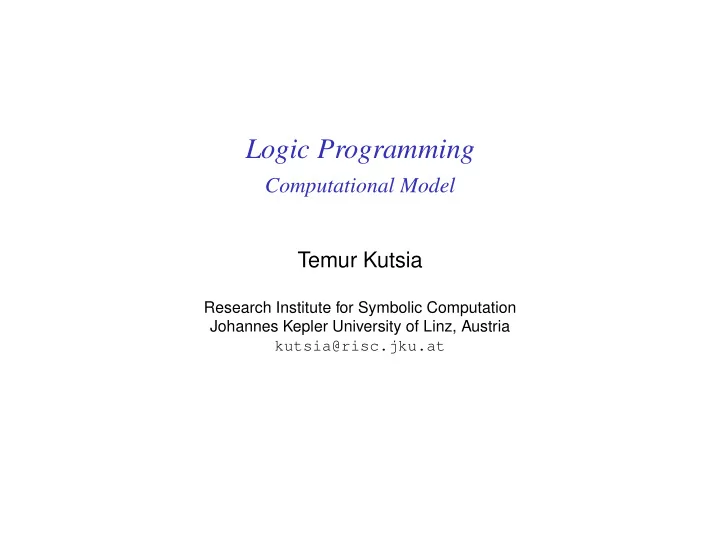

Logic Programming Computational Model Temur Kutsia Research Institute for Symbolic Computation Johannes Kepler University of Linz, Austria kutsia@risc.jku.at
Contents Preliminaries Abstract Interpreter Choice Points
Basic Notions Term: Constant, variable, or compound term. Compound Term: Functor, arguments f ( t 1 , . . . , t n ) Functor: Name, arity f / n Goal: Atom or compound term.
Logic Programs Clause: Universally quantified logical sentence A ← B 1 , . . . , B k , k ≥ 0 A and B i ’s are goals. Declarative reading: A is implied by the conjunction of the B i ’s. Procedural reading: To answer the query A , answer the conjunctive query B 1 , . . . , B k . Logic Program: Finite set of clauses.
Computation Query: Existentially quantified conjunction ← A 1 , . . . , A n , n > 0 A i ’s are goals. Computation of a Logic Program P : finds an instance of a given query logically deducible from P .
How to Compute ◮ Start from initial query G . ◮ Computation terminates – success or failure. ◮ Computation does not terminate – no result. ◮ Output of a successful computation: the instance of G proved. ◮ A given query can have several successful computations with different output.
Abstract Interpreter INPUT: A logic program P and a query G . OUTPUT: G θ , if this was the instance of G deduced from P , or failure if failure has occurred.
Abstract Interpreter ALGORITHM: Let resolvent be G While resolvent is not empty do 1. Choose a goal A from resolvent . 2. Choose a renamed clause A ′ ← B 1 , . . . , B n from P such that A and A ′ unify with an mgu θ ( exit if no such goal and clause exist). 3. Remove A from and add B 1 , . . . , B n to resolvent . 4. Apply θ to resolvent and to G . If resolvent it empty, return G , else return failure .
Choosing and Adding Choosing and Adding: ◮ Left unspecified in the abstract interpreter. ◮ Must be resolved in a realization of the computational model.
Two Choices Completely different nature. Choice of a goal: ◮ Arbitrary. ◮ Does not affect computation. ◮ If there exists a successful computation by choosing one goal, then there is a successful computation by choosing any other goal. Choice of a clause: ◮ Non-deterministic. ◮ Affects computation. ◮ Choosing one clause might lead to success, while choosing some other might lead to failure.
Adding Goal to Resolvent Assume: Always the leftmost goal to be chosen Then: Adding new goal to the beginning of the resolvent gives depth-first search. Adding new goal to the end of the resolvent gives breadth-first search.
Prolog’s Solution ◮ Choice of a goal: leftmost. ◮ Choice of a clause: Topmost. ◮ Adding new goal to the resolvent: At the beginning.
Recommend
More recommend